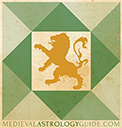The Classical Planets of Medieval Astrology
One of the first things that people who come from more modern forms of astrology notice about medieval astrology is that there are fewer planets in astrological charts. Specifically, the outer planets Uranus, Neptune, and Pluto are typically not present. Why is that?
Charts of contemporary practitioners of medieval astrology usually exclude the outermost planets Uranus, Neptune, and Pluto. The reason for this changes from astrologer to astrologer, but it's important to remember that these planets have only been known about for a relatively short amount of time. Uranus was the first new planet to be discovered in 1781. The other planets (Moon, Mercury, Venus, Sun, Mars, Jupiter, and Saturn) have been a part of the human experience since antiquity. In a very real sense, the system of astrology was designed around the inclusion of seven planets. This makes the outer three more like awkward add-ons than expansions.
Not only is the system designed to operate with a specified number of players, but the new planets move so excruciatingly slowly that they become difficult to work with in any practical sense. Even modern forms of astrology admit this by grouping these three together as "generational planets". They don't do a lot for individuals and are more indicative of shifting values throughout history.
At the core of this dismissal of or conscious choice to ignore the outer planets is a deeper problem within astrology itself; the lack of a definition of the word "planet". The word itself comes from the Greek "planetes asteres" which literally means "wandering star". While the rest of the host of stars in the night sky all move in one mass, seven stars moved with a unique motion in their own paths; these are the classical seven planets. Astronomers have since changed the definition of "planet" to fit their own needs, but astrologers never updated and instead just followed the astronomical designation. This lack of foresight and technical clarity came back to bite astrologers when, in 2006, astronomers revoked Pluto's planethood after adopting a more formal definition. So now Pluto is not a planet, but many astrologers continue to use it as if it were.
Furthermore, there are even philosophical concerns about the lack of light that these bodies show. In medieval and other classical forms of astrology, celestial light has powerful and unique properties. Light is the only way in which the planets interact with the world below and many technical terms within astrology refer to light and vision with an implication that this light is the vehicle for astrological influence. The seven classical planets all have distinct and observable light that humans are capable of seeing and tracking, but the outer planets do not (which is why it took us so long to know they were there). This makes their use questionable in many practices.
Not all classically trained astrologers dismiss the outers completely, but they are used very differently than the original planets. The most obvious difference is that these bodies are not considered to rule signs, so Pisces, Aquarius, and Scorpio are still considered the signs of Jupiter, Saturn, and Mars. This reduces the utilization of the outers significantly in classical techniques. Similarly they are often overlooked unless they manage to make themselves significant by being conjoined an angle or important planets. These methods see the outers approached more like faster fixed stars than planets in their own right.
So, the next time you look at your chart, ask yourself if Uranus, Neptune, and Pluto are in significant positions and see whether or not they are actual significant players, or if they are more muted in the background.
Who invited these guys?
There. That’s better.


